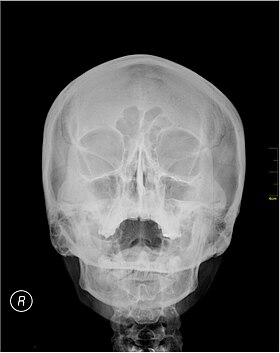| Waters' view | |
|---|---|
 A Waters' view radiograph showing the paranasal sinuses A Waters' view radiograph showing the paranasal sinuses | |
| Specialty | Radiology |
| [edit on Wikidata] | |
Waters' view (also known as the occipitomental view or parietoacanthial projection) is a radiographic view of the skull. It is commonly used to get a better view of the maxillary sinuses. An x-ray beam is angled at 45° to the orbitomeatal line. The rays pass from behind the head and are perpendicular to the radiographic plate. Another variation of the waters places the orbitomeatal line at a 37° angle to the image receptor. It is named after the American radiologist Charles Alexander Waters.
Uses
Structures observed
Waters' view can be used to best visualise a number of structures in the skull.
- Maxillary sinuses.
- Frontal sinuses, seen with an oblique view.
- Ethmoidal cells.
- Sphenoid sinus, seen through the open mouth.
- Odontoid process, where if it is just below the mentum, it confirms adequate extension of the head.
The frontal sinus may not show the frontal sinus in detail.
Interpretation of results
| Pathology | Observation |
|---|---|
| None (Normal) |
|
| Maxillary sinusitis | 
|
| Polyp |
|
| Malignancy |

|
Procedure

Typically, the x-ray beam is angled at 45° to the orbitomeatal line. Another variation of the waters places the orbitomeatal line at a 37° angle to the image receptor, or 30°.
History

Waters' view is named after the American radiologist Charles Alexander Waters. It is also known as the occipitomental view.
References
- Freeman, M. Brandon; Harshbarger, Raymond J. (2010). "44 - Fractures of the Frontal Sinus". Plastic Surgery Secrets Plus (2nd ed.). Mosby. pp. 291–294. doi:10.1016/B978-0-323-03470-8.00044-2. ISBN 978-0-323-03470-8.
- ^ Ruprecht, Axel; Lam, Ernest W. M. (2014). "26 - Paranasal Sinus Diseases". Oral Radiology - Principles and Interpretation (7th ed.). Mosby. pp. 472–491. doi:10.1016/B978-0-323-09633-1.00026-2. ISBN 978-0-323-09633-1.
- Butler, Paul; Mitchell, Adam W. M. (Oct 28, 1999). Applied Radiological Anatomy. p. 97. ISBN 9780521481106.
- Merrill's Atlas of Radiographic Positioning and Procedures. Vol. 2. p. 328.
- ^ Archer-Arroyo, Krystal; Mirvis, Stuart E. (2020). "1.2 - Radiological Evaluation of the Craniofacial Skeleton". Facial Trauma Surgery - From Primary Repair to Reconstruction. Elsevier. pp. 16–31. doi:10.1016/B978-0-323-49755-8.00010-4. ISBN 978-0-323-49755-8. S2CID 198282822.
- Chiu, Tor Wo (2019). Stone's plastic surgery facts : a revision guide (4 ed.). Boca Raton, FL: CRC Press. ISBN 978-1-315-18567-5. OCLC 1060523898.